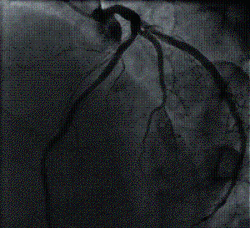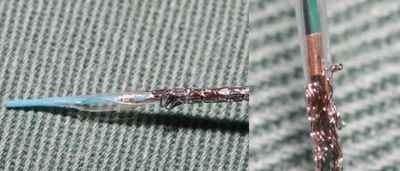The doctor will take your medical history and give you a physical examination. If the doctor suspects Acute Coronary Syndrome, the following tests will usually be performed:
- Blood test
- An electrocardiogram (ECG) to determine the electrical activity of the heartbeats
Additional tests may be ordered by the doctor to further examine the condition of your heart.
Electrocardiogram (ECG or EKG)
An electrocardiogram (ECG or EKG) is a non-invasive test that measures the electrical activity of the heartbeats. An electrical impulse travels through the heart with each beat. This impulse causes the heart muscle to squeeze and pump blood. An electrocardiographic machine detects these impulses and records them in the form of waves.
This test allows the doctors to evaluate the regularity of the patient's heart rhythm or detect any abnormality.
Why is it done?
An ECG gives two major kinds of information. First, by measuring time intervals on the ECG, a doctor can determine how long the electrical wave takes to pass through the heart. Finding out how long a wave takes to travel from one part of the heart to the next shows if the electrical activity is normal or slow, fast or irregular. Second, by measuring the amount of electrical activity passing through the heart muscle, a cardiologist may be able to find out if parts of the heart are too large or are overworked.
Does it hurt?
No. There’s no pain or risk associated with having an electrocardiogram. When the ECG stickers are removed, there may be some minor discomfort.
Coronary Angiography

Coronary Angiography is a procedure to visualise the coronary arteries. The coronary arteries are the blood vessels that supply blood to the heart muscles. On ordinary chest X-ray films, the heart appears as a silhouette and the coronary arteries cannot be seen. To see the coronary arteries, a special dye or contrast medium is injected through a small tube (catheter) inserted into a large artery in the groin or the wrist. The catheter is then advanced to the heart and positioned at the mouths of the coronary arteries before injection is performed.
Coronary Angiography is therefore an invasive procedure. Sometimes, another procedure called a left ventriculography is performed at the same session, whereby a catheter is advanced into the left ventricle (the lower and larger heart chamber) and contrast medium is injected. This allows visualisation of the left ventricle and its contractions.
What is the purpose of this test?

In some people, the coronary arteries become narrowed, usually by a process called atherosclerosis in which cholesterol and other substances are deposited in the arterial wall. With progressive narrowing, the blood supply to the heart muscle gradually decreases, and eventually becomes insufficient to supply its needs. This usually results in chest pain (angina pectoris) during exertion or stress, but may also manifest as breathlessness, irregular heart rhythm or fatigue. When a blood vessel suddenly occludes completely, a full-blown heart attack occurs. Coronary artery disease is a common disease and a major killer in Singapore.
Coronary Angiography is carried out to determine whether there is any significant narrowing or blockage in the coronary arteries. Once determined, the doctor will decide on the best form of treatment.
It is also performed before Coronary Angioplasty (ballooning) is carried out to provide a 'road map' for guiding the Angioplasty procedure.

What to expect?
The procedure may be performed on an outpatient basis, or you may be admitted overnight.
Before the procedure:
- Routine investigations, including blood tests, an Electrocardiogram (ECG) and a chest X-ray may be carried out.
- Food and water are not allowed 6-8 hours before the procedure.
- A small cannula will be inserted in one of the veins on your hand/arm to facilitate injection of medicine, if necessary.
- You would be asked to sign a consent form after your doctor has explained the risks of the procedure to you.
On the day of the procedure:
- On the morning of the test, you will be asked to empty your bladder, and the skin on your groins and upper thighs will be shaved.
- You will be brought to the Invasive Cardiac Laboratory where you will be placed on a movable table, with X-ray cameras and LCD monitors around you.
- Do not be alarmed by the sound of the machines and you should try to relax and keep still.
- A nurse will clean your groin or wrist, then drape you with sterile towels.
- The cardiologist performing the procedure will first apply local anaesthetic on either area before the catheter is inserted into your body.
- The procedure is painless, except for the initial injection of local anaesthetic.
- If left ventriculography is performed, you will feel a warm sensation in your chest which then moves down to your legs during the injection of the contrast medium for a few seconds.
After the procedure:
- The procedure normally takes 15-30 minutes, following which the catheters will be removed.
- Upon removal, the doctor will discuss his findings with you.
- Your puncture site will be compressed for about 10 to 15 minutes until the bleeding stops and the compressive bandage will be applied.
- You would be brought back to your hospital bed where you will have to lie flat on your back for 4-6 hours until the doctor verifies that you are fit to walk.
- Your doctor will then discuss the findings of the angiography, as well as treatment options.
- You can be discharged in the evening on the same day or early next day.
What to prepare?
- Please inform your doctor of any allergy, in particular, allergies to seafood, iodine, X-ray contrast medium and pain relieving medications.
- Please inform your doctor if you have a history of peptic ulcer disease, recent strokes, or bleeding tendencies.
- If you are suffering from diabetes mellitus and you are taking a medication called metformin, please inform your doctor. You will need to stop this particular medication for at least 2 days before and after the Angiography.
- Bring along some light reading material or a mini radio for your hospital stay as you will be spending much of your time in bed.
- Please bring all your medication with you. You will be instructed on the medication that you will need to omit before the test.
What are the potential risks or complications?
Coronary Angiography is one of the safest invasive procedures. There is a small risk of injury and complications with regards to this procedure. The most common complications are minor bleeding, swelling and bruising from the puncture site, and an allergic reaction to the contrast medium. There is a very small risk (0.1%) of a heart attack or stroke occurring during the procedure, and an even smaller risk (less than 0.1%) of major life-threatening complications.
Home care
- Resume normal daily activities.
- Notify the doctor at once if you experience bleeding or increased bruising at the puncture site; or if you experience a recurrence of symptoms, such as breathlessness or decreased exercise tolerance.





















